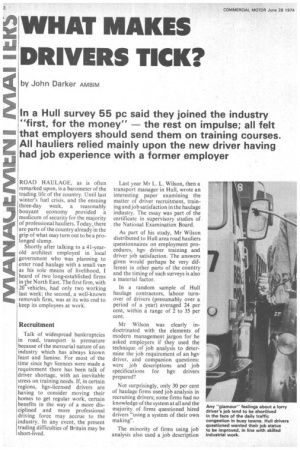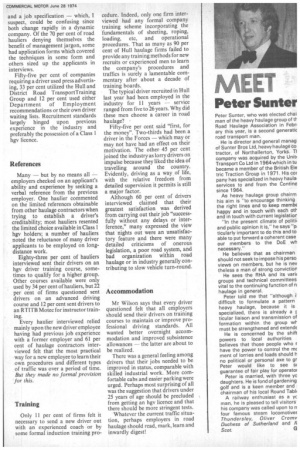WHAT MAKES DRIVERS TICK?
Page 54

Page 55

If you've noticed an error in this article please click here to report it so we can fix it.
by John Darker AMBIM
In a Hull survey 55 pc said they joined the industry "first, for the money" — the rest on impulse; all felt that employers should send them on training courses. All hauliers relied mainly upon the new driver having had job experience with a former employer
ROAD HAULAGE, as is often remarked upon, is a barometer of the a trading life of the country. Until last winter's fuel crisis, and the ensuing three-day week, a reasonably bouyant economy provided a modicum of security for the majority of professional hauliers. Today, there are parts of the country already in the grip of what may turn out to be a prolonged slump.
Shortly after talking to a 41-yearold architect employed in local government who was planning to enter road haulage with a small van as his sole means of livelihood, I heard of two long-established firms in the North East. The first firm, with 20 vehicles, had only two working last week; the second, a well-known removals firm, was at its wits end to keep its employees at work.
Recruitment
Talk of widespread bankruptcies in road, transport is premature because of the mercurial nature of an industry which has always known feast and famine. For most of the time since hgv licences were made a requirement there has been talk of driver shortage, with an inevitable stress on training needs. If, in certain regions, hgv-licensed drivers are having to consider moving their homes to get regular work, certain benefits in the way of a more disciplined and more professional driving force may accrue to the industry. In any event, the present trading difficulties of Britain may be short-lived. Last year Mr L. L. Wilson, then a transport manager in Hull, wrote an interesting paper examining the matter of driver recruitment, training and job satisfaction in the haulage industry. The essay was part of the certificate in supervisory studies of the National Examination Board.
As part of his study, Mr Wilson distributed to Hull area road hauliers questionnaires on employment procedures, hgv driver training and driver job satisfaction. The answers given would perhaps be very different in other parts of the country and the timing of such surveys is also a material factor.
In a random sample of Hull haulage contractors, labour turnover of drivers (presumably over a period of a year) averaged 24 per cent, within a range of 2 to 35 per cent.
Mr Wilson was clearly indoctrinated with the elements of modern management jargon for he asked employers if they used the technique of job analysis to determine the job requirement of an hgv driver, and companion questions: were job descriptions and job specifications for hgv drivers prepared?
Not surprisingly, only 30 per cent of haulage firms used job analysis in recruiting drivers; some firms had no knowledge of the system at all and the majority of firms questioned hired drivers "using a system of their own making".
The minority of firms using job analysis also used a job description and a job specification — which, I suspect, could be confusing since both change rapidly in a dynamic company. Of the 70 per cent of road hauliers denying themselves the benefit of management jargon, some had application forms which covered the techniques in some form and others sized up the applicants in interviews.
Fifty-five per cent of companies requiring a driver used press advertising, 33 per cent utilized the Hull and District Road TransportTraining Group and 12 per cent used either Department of Employment recommendations or their own driver waiting lists. Recruitment standards largely hinged upon previous experience in the industry and preferably the possession of a Class I hgv licence.
References
Many — but by no means all --employers checked on an applicant's ability and experience by seeking a verbal reference from the previous employer. One haulier commented on the limited references obtainable from other haulage contractors when trying to establish a driver's creditability; most hauliers resented the limited choice available in Class 1 hgv holders; a number of hauliers noted the reluctance of many driver applicants to be employed on longdistance work.
Eighty-three per cent of hauliers interviewed sent their drivers on an hgv driver training course, sometimes to qualify for a higher group. Other courses available were only used by 34 per cent of hauliers, but 22 per cent of firms questioned sent drivers on an advanced driving course and 12 per cent sent drivers to an RTITB Motec for instructor training.
Every haulier interviewed relied mainly upon the new driver employee having had previous job experience with a former employer and 61 per cent of haulage contractors interviewed felt that the most practical way for a new employee to learn their own procedures and different types of traffic was over a period of time. But they made no formal provision for this.
Training
Only II per cent of firms felt it necessary to send a new driver out with an experienced coach or by some formal induction training pro cedure. Indeed, only one firm interviewed had any formal company training scheme incorporating the fundamentals of sheeting, roping, loading, etc, and operational procedures. That as many as 90 per cent of Hull haulage firms failed to provide any training methods for new recruits or experienced men to learn the company's procedures and traffics is surely a lamentable commentary after about a decade of training boards.
The typical driver recruited in Hull last year had been employed in the industry for 11 years — service ranged from five to 26 years. Why did these men choose a career in road haulage?
Fifty-five per cent said "first, for the money". Two-thirds had been a driver in the Forces — which may or may not have had an effect on their motivation. The other 45 per cent joined the industry as lorry drivers on impulse because they liked the idea of travelling around the country. Evidently, driving as a way of life, with the relative freedom from detailed supervision it permits is still a major factor.
Although 60 per cent of drivers interviewed claimed that their greatest satisfaction was derived from carrying out their job "successfully without any delays or interference," many expressed the view that nights out were an unsatisfactory feature and there were many detailed criticisms of onerous legislation, a poor road system, and bad organization within road haulage or in industry generally contributing to slow vehicle turn-round.
Accommodation
Mr Wilson says that every driver questioned felt that all employers should send their drivers on training courses to maintain or improve professional driving standards. All wanted better overnight accommodation and improved subsistence allowances the latter are about to be realized.
There was a general feeling among drivers that their jobs needed to be improved in status, comparable with skilled industrial work. More comfortable cabs and easier parking were urged. Perhaps most surprising of all was the suggestion that drivers under 25 years of age should be precluded from getting an hgv licence and that there should be more stringent tests.
Whatever the current traffic situation, perhaps employers in road haulage should read, mark, learn and inwardly digest!












































































































